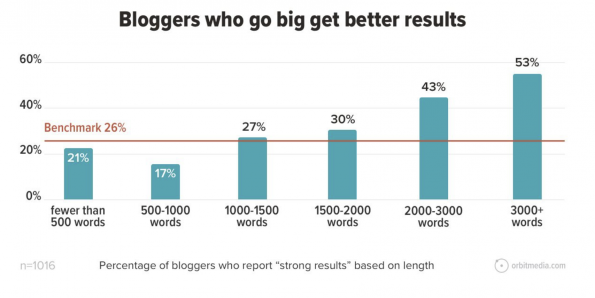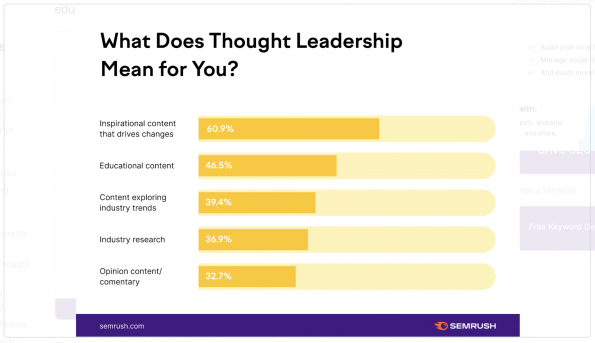Long-Form Authority: Does Long-Form Content Improve Thought Leadership?
Thought leadership is a type of content marketing where businesses use the expertise, valued opinions and experiences of their employees to educate their target audience on a particular topic within the industry.
65.4% of businesses already include thought leadership in their content marketing strategy as it establishes brand credibility and authority, generates backlines, shares and mentions, and attracts potential customers.
To become a thought leader, an author or business must consistently produce and publish content that shows consumers that they are an expert on specific topics within the industry. We recommend demonstrating this prowess in the form of long-form content.
So, what is long-form content, and how can it improve thought leadership?
What Is Long-Form Content?
Long-form content is a comprehensive piece of text or video that covers all areas of a topic while remaining clear and engaging to the consumer.
Generally, if a piece of text is more than 1,000 words and a video is between 15 minutes and one hour, it’s considered long-form content. However, bloggers who write more than 3000 words in an article are 2.5x as likely to report strong results.

(Image Source: Orbit Media)
Long-form content can be used to build authority, credibility and thought leadership on a topic which is excellent for search engine optimisation (SEO). Meanwhile, short-form content ranks number one for lead generation and engagement.
However, the founder and host of the Unthinkable podcast, Jay Acunzo, disagreed with short-form trends. He said: “When it comes to length, bloggers need to resist the rally cry of so many under-informed marketers who claim that the world is trending short-form, so you must too. Audiences don’t have a lower tolerance for long-form. They have a lower tolerance for mediocrity.
“We need to decouple the question of length from the question of value. The latter needs to be apparent immediately, delivered powerfully, and combined with good storytelling techniques like open loops and moments of tension to hold people’s attention.”
Here are some examples of long-form content:
- Articles (websites or magazines)
- Case studies (success stories)
- Interviews
- Blog posts (this can also be written as short-form content)
- White papers (reports or guides)
- E-books
- Long-form videos or podcasts (recorded live events, interviews or webinars)
Here are some of the advantages of long-form content:
- The backbone of a marketing strategy. Information from long-form articles can be refreshed into short-form content such as infographics, and videos can be repurposed for social media.
- Great for SEO. Google ranks web pages in order of most high-quality content, which is determined by the word count, the number of relevant search terms in the content and the amount of time users spend on the page.
- Likely to get backlinks. The more comprehensive your piece, the more likely it is that another website will link back to you.
- Thought Leadership. Writing a long, in-depth piece on a particular topic showcases you as an expert, attracting people who want to hear your take.
- Builds credibility. As mentioned, long-form content can position a brand as a thought leader, which builds credibility and a good reputation.
- Highly shareable. Surveys show that content with 3,000 to 10,000 words gets the most average shares, especially on Facebook.
Does Long-Form Content Improve Thought Leadership?
Data shows that long-form content, leading with articles and blog posts, is ideal for businesses using thought leadership as a content marketing strategy. This is because consumers are more likely to trust the words of long-form content over short-form content such as social media posts.

(Image Source: Sem Rush)
Long-form content can help improve thought leadership as a business or author needs credibility, backlinks, shares and a high SEO ranking to be trusted by consumers and become a thought leader. Thought leaders are also likely to have:
- Strong opinions. Those who take a stand about their beliefs despite the risk of making someone unhappy.
- Industry knowledge. Being knowledgeable about a topic will make others follow.
- Experience sharing experiences with the public. It’s also helpful if they can prove their credibility.
- A good following. This could be a social media following or being a reliable source that a business runs to when they need answers about a topic.
Examples of How Long-Form Content Can Improve Thought Leadership
White papers
Comprehensive papers, guides and reports that present original research findings, data, and industry trends improve thought leadership by providing evidence-based insights.
Articles and blog posts
Articles and blog posts that offer knowledgeable insights and solutions to industry challenges improve thought leadership by showing an understanding of the industry or topic.
In addition, articles and blog posts are great places for SEO keywords that help a web page rank higher on the search engine, increasing a thought leader’s credibility.
Case studies
Case studies show consumers and businesses successful outcomes, which can improve thought leadership by highlighting the expertise and problem-solving capabilities of the thought leader.
In addition, quantifiable data can earn backlinks from high-authority websites to the thought leader’s original case study.
Videos
Interactive presentations or webinars allow a thought leader to discuss a topic with their audience in a dynamic and engaging environment, followed by questions which can improve the audience’s thoughts on the presenter’s knowledge.
Podcasts and interviews
Hosting or participating in podcasts and interviews can improve thought leadership as the expert is given a chance to discuss industry topics, share insights and engage in conversations with other industry peers and experts.
Future of Thought Leadership
In the future, thought leaders will be expected to accept a more significant shift towards visual content as it improves engagement, enhances branding and increases accessibility.
Various technological tools and platforms will also be incorporated into thought leadership, including artificial intelligence (AI). With the increasing use of AI-powered assistants and virtual reality technologies, thought leaders can reach their target audiences more effectively and engage in meaningful conversations with consumers.
The future will also see that more individuals from diverse backgrounds have the opportunity to become thought leaders, ultimately leading to a wider variety and a better understanding of more topics.

